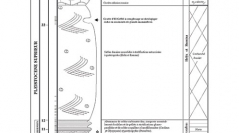

 Comptes Rendus Palevol
4 (4) - Pages 317-325
Comptes Rendus Palevol
4 (4) - Pages 317-325The Quaternary series outcropping in the Cap Bon area (North-East of Tunisia) is characterised by two types of facies. The lower one is rich in warm marine molluscs such as Strombus bubonius LAMARCK, which expanded during the transgressive Tyrrhenian period, along the south margin of the Mediterranean Sea and elsewhere around this marine basin. The upper facies is continental and rich in gastropoda such as Helix and Rumina . In the deposits of this upper facies, a cave rich in big mammalia remains is discovered. These fossils are attributed to six species, composed at least of 12 individuals of grazer big mammalia belonging to groups such as Equids, Rhinocerotids, Bovids, and Hystricids. All these species, attributed to Late Pleistocene period, could be adapted to large open biotopes and especially dry climate biotopes, where a savannah vegetal cover was developed.
Quaternary, Cap Bon (Tunisia), Coastal environment, Regressive dune, Mammalia